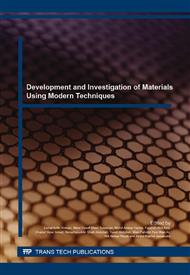p.66
p.71
p.77
p.82
p.87
p.91
p.97
p.103
p.108
Synthesize CCTO Using Different Mixing Media
Abstract:
In recent years, there has been an increasing interest on high dielectric constant that have significant applications in electronic devices. Dielectric materials have many technological applications such as capacitors, resonators and filters. High dielectric ceramic capacitors based perovskite oxides are necessary for modern electronic devices and are found to be suitable for a wide range of applications. Subramanian et al. discovered the high dielectric constant of CaCu3Ti4O12 (CCTO) ~ 10,000 at room temperature. CCTO has the cubic perovskite crystal structure and high dielectric constant of ~ 104 up to 105 at radio frequency and good temperature stability over a wide temperature range [1,2]. These properties were desired for various microelectronic applications. With the high dielectric constant, the material can store more charge and the values make CCTO an attractive material for ultra-high energy density capacitors. However, this properties can be accomplished if single phase of CCTO is formed. Many research have been done recently on the synthesis of the cubic perovskite CCTO and many techniques are working such as sol-gel route [3], combustion techniques [4], molten salt process [5] and etc., but this technique is difficult and complex process during sample preparation.
Info:
Periodical:
Pages:
87-90
Citation:
Online since:
January 2016
Keywords:
Price:
Сopyright:
© 2016 Trans Tech Publications Ltd. All Rights Reserved
Share:
Citation:


